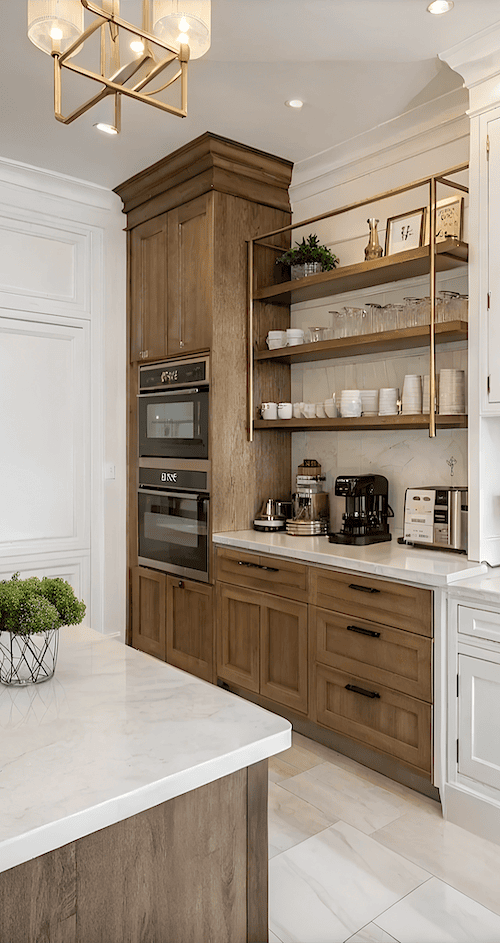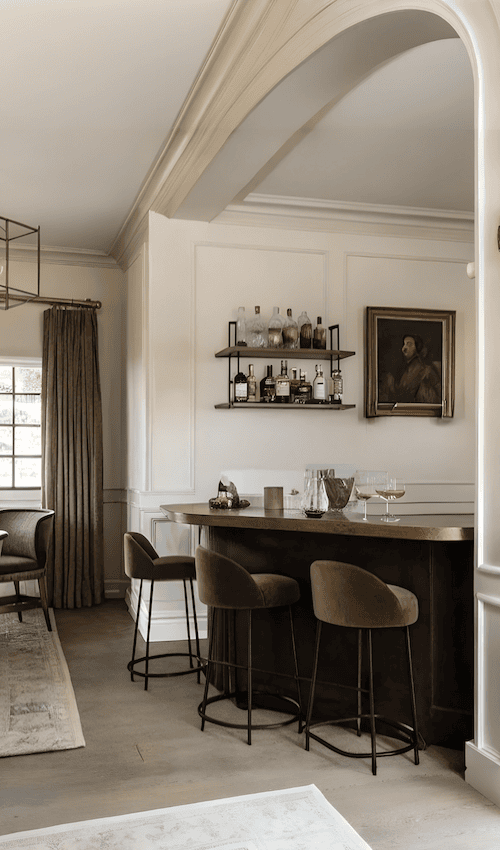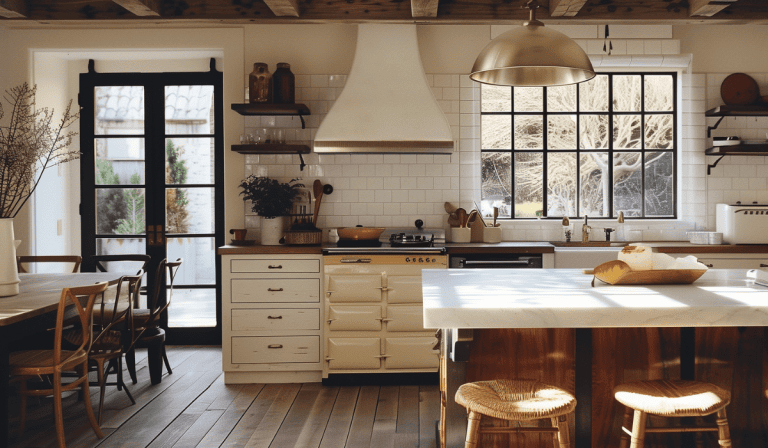Apothecary Kitchens Oozing Old World Charm

One challenge you might encounter when searching “Apothecary Kitchens” on Pinterest is that many of the images you’ll see lean more toward dingy garden shed vibes than the luxurious, old-world kitchens you’d actually love to spend time in.
So, I’m here to fix that problem, by showing you a ton of gorgeous apothecary kitchen design inspo. In this guide to apothecary kitchen design, we will cover some of the must-know tips for nailing this witchy kitchen aesthetic – while keeping it fresh and elegant.

What are Apothecary Kitchens?
The apothecary kitchen style is all about nostalgia: think herbalists and vintage pharmacists.
Back in the day, apothecary spaces were defined by meticulously labeled drawers, glass jars filled with mysterious concoctions, and rich, dark woods. The vibe was practical yet charming, and it still works beautifully in kitchens today.
Make sure you get my home decorating book, which includes bonus resources to help you style your home like an absolute pro - yours FREE today!
As an affiliate partner of various brands and sponsored content, we may earn commission on qualifying purchases. Disclaimer | Advertise With Us
But don’t worry – you don’t need to recreate an actual 1800s chemist’s shop! Instead, we will focus on the design elements that feel timeless: rich materials, organized storage, and a sense of purpose.
Apothecary-inspired kitchens are about creating a space where everything has a place, and everything is beautiful to look at.
Choosing High-End Materials For Your Apothecary Kitchen Design
To make your apothecary kitchen feel elevated and luxe (instead of like a costume party gone wrong), start with your materials.

Cabinetry: Dark wood tones like walnut or mahogany scream sophistication, but if you want something lighter, go for painted finishes in deep greens, blacks, or creamy whites. Bonus points for shaker-style cabinets or anything with vintage hardware.
Countertops: This is not the time for cheap laminate. Go for stone materials like marble, quartzite, or soapstone, they bring the old-world drama and last forever.
Flooring: Reclaimed wood or patterned tiles can add texture and warmth while keeping the overall look cohesive.
The key here is to stick to high-quality, durable materials. They not only look amazing but will also hold up to the demands of a working kitchen.
Must-Have Features of an Apothecary Kitchen
Now that you’ve got your materials picked out, it’s time to add the features that really make this style sing.

Glass-front cabinetry: Perfect for showing off your curated collection of apothecary jars, vintage-inspired dishware, or even a neatly stacked pile of cookbooks.
Open shelving: Done right, this is a great way to keep things functional while putting your style on display. Use it to house glass jars of spices, dried herbs, or copper pots for that vintage flair.
Small drawers or cubbies: Apothecary kitchens are all about organization, so small, labeled pull-out drawers (for spices, teas, or even coffee pods) are both practical and adorable.

A butler’s pantry: If you’re going for ultimate luxury, a butler’s pantry is the move. Use it to store bulk items or as a staging area for entertaining; it’s like the cherry on top of your apothecary aesthetic.

These features bring authenticity to the design without sacrificing the convenience you need in a modern kitchen. Plus, they’re just fun to look at
Lighting to Set the Mood
Lighting makes or breaks an apothecary kitchen. Go too harsh, and you’ve got a hospital lab. Too dim, and you’re cooking in a crypt. The goal? Warm, layered lighting that whispers, “cozy old-world charm,” but still lets you see what you’re doing.
Statement fixtures: Think antique-inspired chandeliers, industrial pendants, or anything that looks like it was salvaged from a historic European pharmacy. Just make sure it’s proportional to your space, no one wants to dodge an oversized chandelier while stirring soup.
Ambient lighting: Under-cabinet lights are your secret weapon. They illuminate your workspace and highlight all those carefully styled apothecary jars. Dimmable lights are also a must for transitioning from meal prep to a moody, after-dinner vibe.
Lighting isn’t just functional, it’s part of the aesthetic. Layer it right, and your kitchen goes from basic to magazine-worthy.
Color Palette and Finishing Touches
Your color palette is the soul of your apothecary kitchen. Stick to muted, earthy tones that feel rich and inviting.
Color suggestions: Warm neutrals, deep greens, matte black, or even soft taupes are your go-tos. Avoid anything too bright or trendy; you want timeless, not dated.

Hardware: Swap out basic handles and knobs for unlacquered brass, oil-rubbed bronze, or antique pewter. These small details bring the “old-world” energy without overdoing it.
Decor: This is where you can have fun. Add vintage scales, herb drying racks, or even a few small potted plants for a touch of life. Just don’t clutter the space. Apothecary style thrives on order and purpose.
Think of the finishing touches as the jewelry for your kitchen: intentional, elegant, and never over-the-top.

Balancing Old World Charm with Modern Luxury
Here’s the challenge: keeping the old-world vibe alive without sacrificing the convenience of modern living. You don’t actually want to cook like it’s the 1800s.
Appliances: Hide modern appliances behind custom cabinetry or opt for retro-inspired designs that blend in seamlessly. A fridge that looks like an antique icebox? Yes, please.

Tech meets tradition: Add smart storage solutions like pull-out spice racks or drawer organizers. You can even sneak in modern touches like touchless faucets or discreet under-counter wine fridges, because what’s more luxurious than that?
The secret is subtlety. Let the charm steal the show, and let the tech work quietly in the background.
Where to Shop for Apothecary-Inspired Pieces
The right sources can make or break your design. Luckily, there are plenty of places to find apothecary-style gems.
High-end retailers: Look for furniture and fixtures at stores like Restoration Hardware, Mcgee and Co, and Anthropologie for luxe, apothecary-inspired options.
Vintage and antique shops: Scour secondhand stores, estate sales, and flea markets for unique finds like labeled jars, vintage scales, and antique hardware.
Online treasures: Etsy is a goldmine for handcrafted or vintage apothecary pieces that will give your kitchen authentic charm.
Mixing high-end items with a few one-of-a-kind vintage finds will create a kitchen that feels unique and layered.
Inspiration: Apothecary Kitchen Ideas
Need some more inspo? Here’s how some kitchens have nailed the apothecary vibe:
Minimalist apothecary: Clean lines, muted colors, and just enough vintage jars and hardware to give a nod to the aesthetic without overwhelming the space.

Maximalist apothecary: Full-on vintage vibes with open shelving, dramatic lighting, and statement pieces like a library ladder for reaching upper cabinets.
I love these brass gallery rails that can be added to any shelf to make it look more vintage and apothecary-style:

Modern mash-up: Sleek cabinetry in rich wood tones paired with vintage lighting and hardware. It’s all about mixing old and new for a perfectly balanced look.

Mistakes to Avoid When Designing An Apothecary Kitchen
Even the best apothecary kitchen dreams can turn into a nightmare if you’re not careful. Here’s what to dodge:
Overdoing the theme: Yes, we love labeled jars, but you don’t need a million of them. Too many “apothecary” touches can feel like a science lab cosplay. Stick to a few well-chosen pieces.
Ignoring functionality: A kitchen that looks stunning but doesn’t work in real life is a hard no. Prioritize smart layouts, easy-to-clean surfaces, and practical storage.
Clashing styles: Mixing in modern elements is great, but they need to vibe with the overall design. That glossy, bright-red toaster? Probably not the move.
Apothecary Kitchens With Old World Charm and All The Witchy Kitchen Vibes – Conclusion
An apothecary kitchen is more than just a design trend, it’s a way to bring timeless charm and personality into your home. When done right, it’s the perfect balance of old-world elegance and modern functionality.
Read this next: The Top Interior Design Trends You’ll Soon Be Seeing Everywhere!












